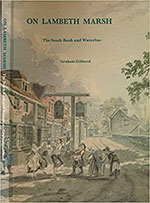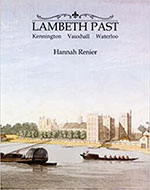Saxon Lambeth
Lambeth (The South Bank) is located on the river Thames and was originally in the county of Surrey. The name Lambeth comes from OE and may have meant 'landing-place for lambs'.
Medieval Lambeth
1062 St. Mary-at-Lambeth built.
1088 Reference to Lamhytha.
1190 Archbishop Baldwin (1125-1190) bought part of Manor of Lambeth from Convent of St Andrew in Rochester.
1197 Archbishop Hubert Walter (c1160-1205) acquired the rest of the manor.
1200 Archbishop Hubert Walter built Lambeth House.
1207 Reference to Lambethe.
1228 Reference to Chapel at Lambeth House.
1378 John Wycliffe (c. 1328-1384) examined at chapel for heresy.
1381 Lambeth Palace sacked during Peasant's Revolt.
1432 Lollards' or water Tower built as safe refuge on north-west corner of Lambeth House. Kentish Rag with a brick turret.
1495 Gatehouse to Lambeth Palace built.
Tudor Lambeth
1513 Reference to Lambeth Horse Ferry.
1553 Thomas More examined in Guard Room of Lambeth House.
Stuart Lambeth
1610 Archbishop Bancroft donated his library to the Palace.
1630s Archbishop William Laud (1573-1645) restored Chapel at Lambeth Palace.

1640 Archbishop Laud attacked by London apprentices.
1650s Lambeth Palace used as a prison until the Restoration.
1660s Great Hall at Lambeth Palace rebuilt.
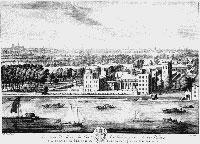
Georgian Lambeth
1746 Rocque’s Map of London (view here).
1750 Westminster Bridge by Charles Labelye (1705–1762) opened.
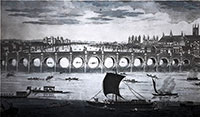
1769 Mrs Eleanor Coade (1733-1821) took on a failing artificial stone manufactory in Lambeth (where the Royal Festival Hall stands today). The artificial stone was renamed Coade stone.
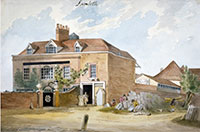
1773 Astley's Amphitheatre opened on Westminster Bridge Road.

1780 Gordon Rioters surrounded the Palace.
1790 William Blake (1757-1827) and his wife lived at 13 Hercules Buildings, a three-storey terrace house (demolished in 1917).
1796 Painting of St Mary Lambeth

1799 Horwood’s map of London (showing Lambeth).
Regency Lambeth
1815 Jones, Watts & Doulton pottery established on Vauxhall Walk, Lambeth (Doulton from 1853).
1817 First Waterloo Bridge by John Rennie (1761-1821)) opened.
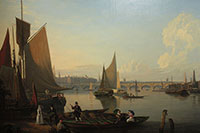
1818 Royal Coburg Theatre opened. Later became the Old Vic.
1824 St Johns Church built on Waterloo Road. Designed by Francis Octavius Bedford (1784–1858).

1826 Doulton & Watts took over a larger existing pottery on Lambeth High Street.
Shot Tower built for Thomas Maltby & Co Lead Works. Designed by David Riddal Roper.
,_p231_(cropped)s.jpg)
1836 Lion Brewery opened on Belvedere Road next to Coade Stone factory.
Early Victorian Lambeth & Waterloo
1837 Coade stone sculpture of a lion by WF Woodington (1806-1893) added to Lion brewery (now on Westminster Bridge). It weighed 13 tons.
Cary’s New Plan of London (map of Lambeth)
1845 Hungerford Suspension Bridge built by Isambard Kingdom Brunel (1806-1859).
1848 Waterloo Station opened by the London and South Western Railway. It replaced Nine Elms station.
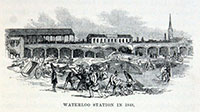
1852 Canterbury Music Hall built by Charles Morton (1819-1904) at 143 Westminster Bridge Road. It specialised in programmes of light music and ballads. First purpose built music hall.
1854 Lambeth School of Art established by William Gregory, vicar of St Mary the Less Church in Princes Road (now called Black Prince Road). Demolished in the 1960s.
1856 Royal Doulton moved to Staffordshire.
Mid Victorian Lambeth & Waterloo
1860 Construction began on the Albert Embankment by John Grant with Joseph Bazalgette (1819-1891) as chief engineer.
1861 Old Lambeth Bridge by PW Barlow (1809-1885) opened.
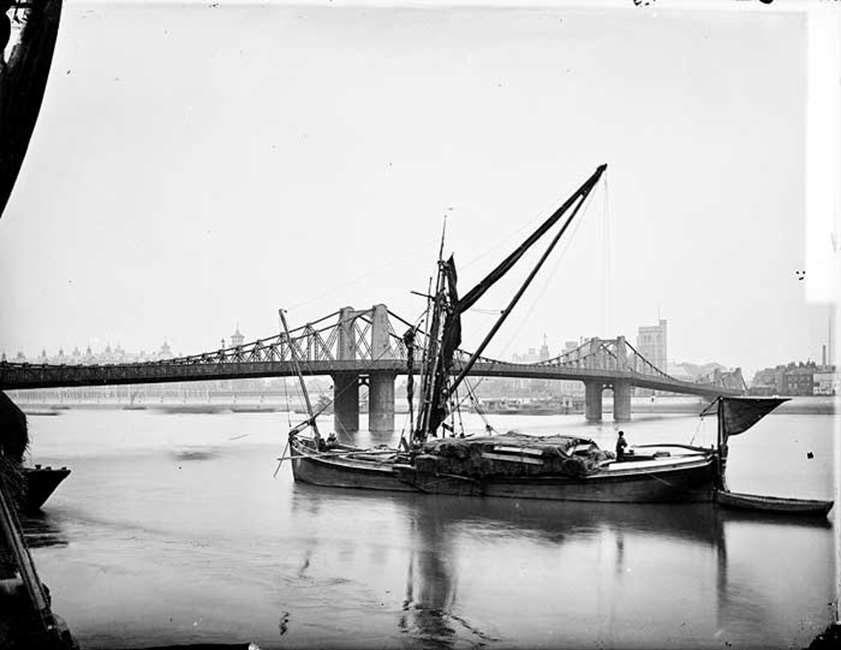
1862 New Hungerford Railway Bridge by John Hawkshaw (1811-1891) built.
Second Westminster Bridge built by Thomas Page (1803-1877).
Stanford’s map of London (view Lambeth).
1865 Work began on St Thomas Hospital. It was on a plot of land
reclaimed from the river during the construction off the Albert Embankment
1867 First Lambeth conference of Anglian bishops held.
1868 Albert Embankment opened.
1869 Waterloo Junction opened by South Eastern railway (renamed Waterloo East in 1977).
1871 New St Thomas Hospital by Henry Currey (1820–1900) opened on Lambeth Palace Road.
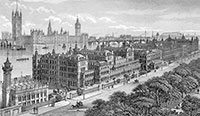
1876 Christ Church opened on Westminster Bridge Road. It included the Lincoln Tower in the Gothic Revival style.
New Canterbury Theatre opened. Designed by Albert Bridgman, as a much larger three tier Theatre
Plan of the Parish of Lambeth by surveyor Hugh McIntosh. Designed by Edward Cookworthy Robins (1830-1918).
Late Victorian Lambeth & Waterloo
1889 Morley College built near Old Vic.
1898 Waterloo to Bank underground line opened as Waterloo to City Line.
Edwardian South Bank
1900 Nine acres of Lambeth Palace land given to public as Archbishops Park.
1906 North Lambeth Underground station by Leslie Green (1875-1908) opened at 110 Westminster Bridge Road.
1908 Bartholomew's Handy Reference Atlas Of London & Suburbs (Lambeth & Waterloo map).
1910 Waterloo Fire station opened.
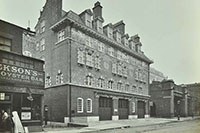
1912 Work begun on County Hall for the London County Council. Designed by Ralph Knott (1878-1929)
Inter-War South Bank
1922 County Hall opened. Six storeys high in the Edwardian Baroque style
New Waterloo Station (Jacomb-Hood) opened by the Queen. Pathe News film. Victory Arch, at main pedestrian entrance, designed by James Robb Scott (1882 – 1965), as a memorial to the 585 company staff killed during the First World War.
1924 Morley College moved to Lambeth North.
1926 Extension of the Northern line from Embankment to Kennington with a new station at Waterloo.
c1930s A Ride over Westminster Bridge film
1932 Second Lambeth Bridge (by George Humphreys, Sir Reginald
Bloomfield and G. Topham Forrest) opened.
1934 News cinema opened in Waterloo station by Platform One. Designed by Alister MacDonald (1898-1993).
1936 Old Waterloo Bridge demolished.
Second World War South Bank
1940 7 Sept: John Street viaduct immediately Waterloo the station destroyed in a bombing raid.
29 Dec: Waterloo station closed again after bombing raid.
1941 5 Jan: Waterloo station offices on York Road were destroyed by bombing.
10–11 May: Waterloo station bombed in a night raid.
1942 Canterbury Theatre bombed.
1945 New Waterloo Bridge by Giles Gilbert Scott (1880-1960) opened.
Post War South Bank
1949 Lion Brewery demolished & Shot Tower closed to make way for work on the Festival of Britain site. Brewery’s Coade stone Lion moved to a plinth outside Waterloo Station Gate (until 1966).
Photo of Dome of Discovery under construction and the Shot Tower in the background.
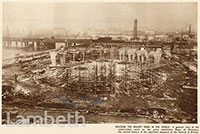
1951 3rd May: Festival of Britain held by Labour government to mark the centenary of the Great Exhibition of 1851. It demonstrated Britain's contribution to civilisation, past, present, and future, in the arts, in science and technology, and in industrial design. It was centred on the South Bank of the Thames. The Skyline became its emblem. Colour film of Festival (9:28) + Film 2 (3:37)
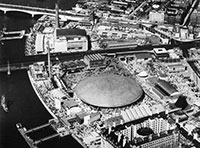
Royal Festival Hall opened. Designed by Leslie Martin (1908-2000), Peter Moro (1911– 1998) & Robert Matthew (1906–1975).
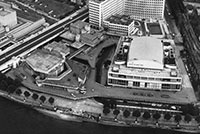
Telekinima by Wells Coates (1895-1958) opened between Waterloo Station and Royal Festival Hall. First cinema in the world specially designed and built to show both films and television.
30 Sept: Closure of The Festival of Britain Film (2:16)
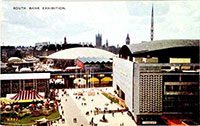
Oct: New PM Winston Churchill ordered the South Bank site to be cleared including the Skyline. Only the Royal Festival Hall remained.
1952 Telekinima retained & run by BFI until it was replaced by National Film Theatre.
1955 Canterbury Theatre demolished.
1956 Royal Doulton closed in Lambeth.
1957 National Film Theatre opened. Designed by Norman Engleback (1927–2015).
Pathe News Film of the Theatre Opening Night (1:31).
1961 Shell Centre opened on York Road. Designed by Sir Howard Robertson (1888-1963), 27 storeys & 351 feet high (now residential flats).
1962 Shot Tower demolished.
1964 Film of the South Bank (12:33)
1966 Coade stone Lion moved to Westminster Bridge as Waterloo Station expanded.
1967 Queen Elizabeth Hall & Purcell Room opened. Both designed by Norman Engleback (1927–2015).
1968 Hayward Gallery opened. Designed by Norman Engleback.
1970 News cinema closed in Waterloo station (demolished in 1988).
1975 New St Thomas Hospital (by Yorke Rosenberg Mardell) opened.
1976 National Theatre by Denys Lasdun (1914-2001) opened.
Museum of Garden History opened at St Mary Church, Lambeth Road, by Rosemary and John Nicholson.
1977 Jubilee Gardens opened on Belvedere Road to celebrate Queen’s Silver Anniversary.
1986 Margaret Thatcher abolished the GLC thus making County Hall redundant.
1994 Waterloo International Station by Nicholas Grimshaw (b. 1939) opened. Connected London to the continent via the new Channel tunnel.

1997 Sea Life London Aquarium opened on the ground floor of County Hall.
1999 BFI Imax by Bryan Avery (1944-2017) opened. Largest screen in Britain (20m high and 26m wide). Seating for just under 500.
2000 Millennium Wheel by David Marks (1952-2017) and Julia Barfield (b. 1952) opened. Renamed London Eye in 2011.
2007 Waterloo International closed (Eurostar service transferred to St Pancras).
2008 Banksy hosted The Cans Festival for Graffiti artists. Situated on Leake Street, a road tunnel previously used by Eurostar.
2012 First-floor balcony opened at Waterloo station to help reduce congestion during the London Olympic Games.
Book list:
The Festival of Britain, the South Bank Exhibition, a Guide to the Story it Tells- Ian Cox (HMSO 1951)
Lambeth Palace - CR Dodwell (Country Life 1958)
The Doulton Lambeth Wares - Desmond Eyles (Hutchinson 1975)
Lambeth's Open Spaces - Marie PG Draper (1979 Lambeth Amenity Services)
Buildings of England London 2: South - Cherry & Pevsner (Penguin 1983)
On Lambeth Marsh: The South Bank and Waterloo - Graham Gibberd (1992)
Lambeth Past - Hannah Renier (2006)
The History of Waterloo Station - John Fareham (2013)
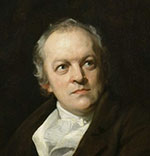
William Blake
Borough History (Old Southwark)
